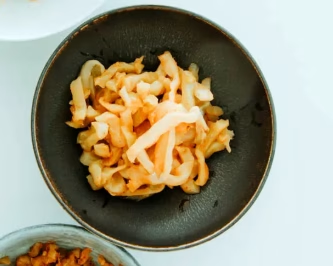What is Zha Cai made of? Zha Cai is a simple pickled vegetable, pickled in salt. It’s said to be one of the world’s three major pickled vegetables, along with European gherkins and sweet and sour cabbage. Don’t miss out on this fascinating exploration of Zha Cai’s secrets.
What vegetable is Zha Cai made of?
Zha Cai is often found in shreds and slices in cooking, but you probably only get a glimpse of its true form when you buy it. Where do these bumpy balls come from?
Zha Cai isn’t made from zucchini. It has a deep connection to other common pickled vegetables like sauerkraut and fu cai. Zha Cai’s predecessor is a type of mustard, called tuberous mustard, a type of cabbage. Its bulbous stems are used to make pickled vegetables, creating a surprisingly delicious flavor.
Why is Zha Cai called “pressed zha Cai”?
Traditional Pickling Methods for Delicious Flavor
Zhacai (zhacai) is a product of salt pickling, which is also where its name comes from. After salting, the mustard greens release water, which must be squeezed out through “pressing.” Traditionally, heavy objects such as stones are used to press and squeeze out the water, creating the “zhacai” (zhacai).
To make zhacai, the mustard greens are first processed and the tough outer skins are removed. Layers of salt and stems are then stacked in a wooden box or jar, allowing the salt to penetrate and release water. After pickling, the water is squeezed out, and the greens are allowed to ferment for over six months. Five-spice powder, chili powder, and other ingredients may be added to enhance the flavor.
Fuling Zhacai
Zhacai is an oriental pickled food. In Asia, the zhacai from Fuling, Chongqing, Sichuan, China, is the most famous. It is a key industrial chain and economic source for Fuling, and its traditional pickling techniques have been listed as a national intangible cultural heritage of China.
The unique practice of preserved mustard in Fuling, China, involves air-drying the mustard before salting. This involves stringing the mustard stems together and hanging them outdoors to dry and release moisture. The spectacle of these large quantities hanging is a local specialty.
Zhacai: Enjoy it in many ways and never tire of it.
Because it’s pickled with a generous amount of salt, its salty flavor and high sodium content are unsurprisingly high, at approximately 2,790 mg per 100 grams. Before cooking, soak the mustard in water for 5-10 minutes to rinse away the salt and impurities. This helps prevent excessive salt intake and reduces the burden on the body.
Stir-fried preserved mustard, with shredded pork being the most classic.
Zhacai can be prepared in a variety of ways. Its salty nature, combined with spices like garlic, scallions, and chili peppers, creates a delicious dish. Stir-fry with oil for a fragrant and crispy dish, eliminating the need for salt. For a more versatile dish, add shredded pork, mushrooms, or bamboo shoots. This pickled mustard greens and pork shreds are perfect with rice or noodles.
Add it to soups for a flavorful and crunchy texture.
Zhacai is also a fantastic seasoning. When sliced, shredded, or even minced, it adds a touch of flavor to any dish.
Add a small amount of sliced mustard greens to chicken or pork rib soup and bring it to a boil for a naturally salty flavor. Add a pinch of salt to taste. Chop it into small pieces and add it to stir-fries or fried rice as a salt substitute for a crunchy texture.
Wrap it around ingredients for a creative twist.
Haven’t you tried wrapping it around ground meat, steamed fish, or steamed buns yet? Just like pickled winter melon, chopping it up and wrapping it around ground meat, or steaming it around fish or tofu is a great way to use it. Give it a try next time!
With mustard greens in season, perhaps it’s time to pickle another batch of mustard greens in winter? Delicious pickled vegetables include not only sauerkraut, pickled mustard greens, and snow mustard, but also pickled mustard greens.


Leave a Reply